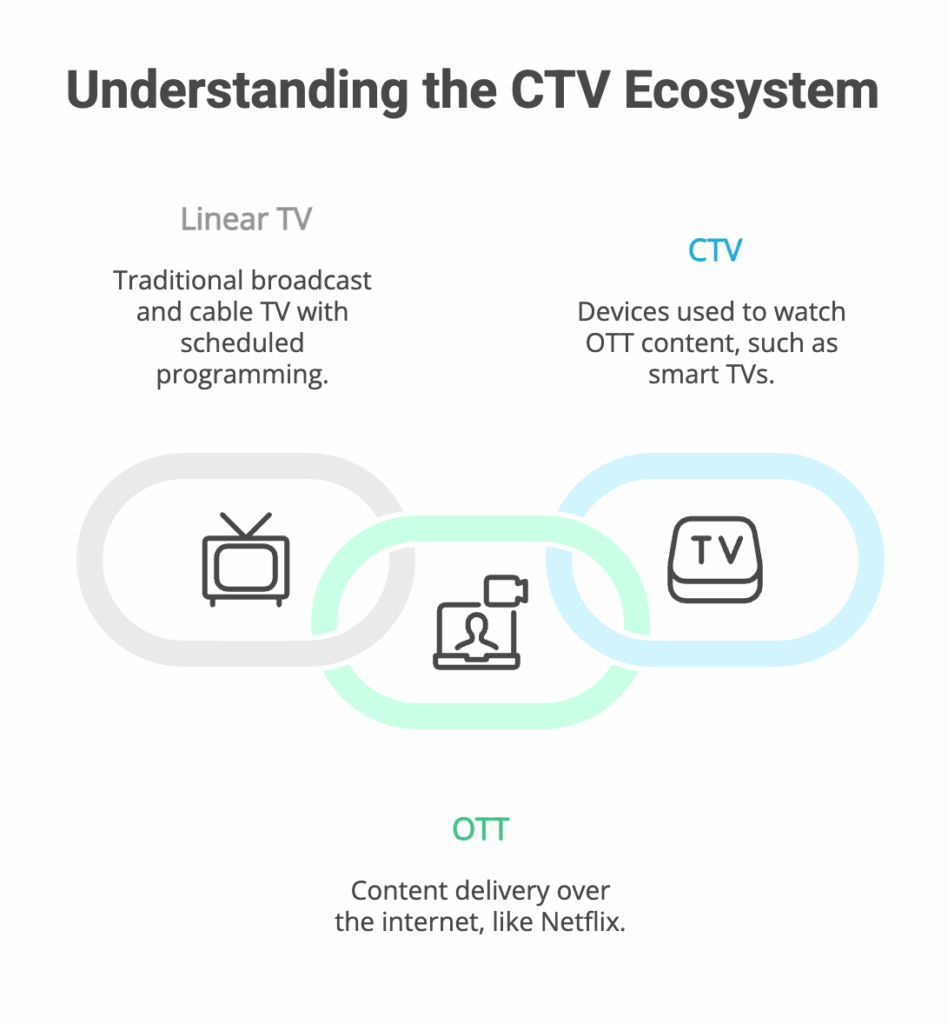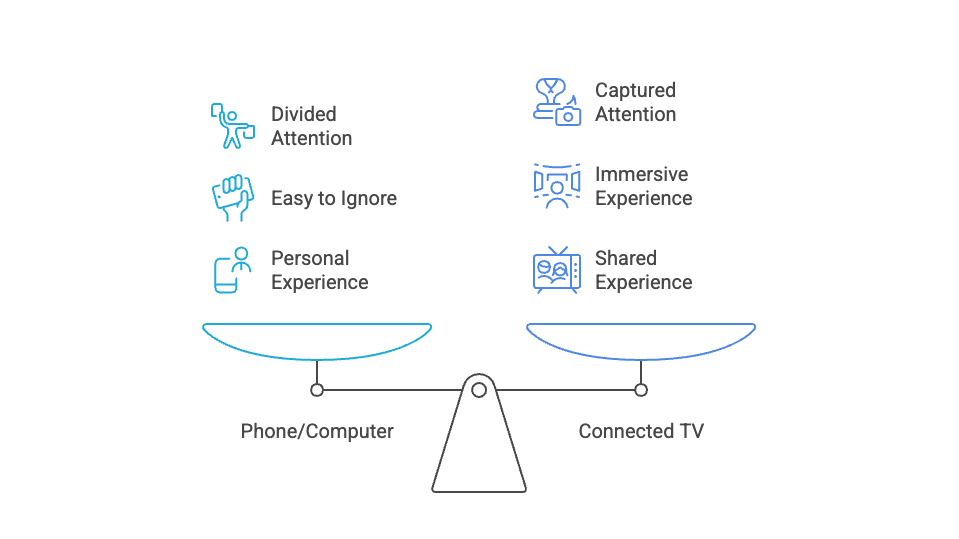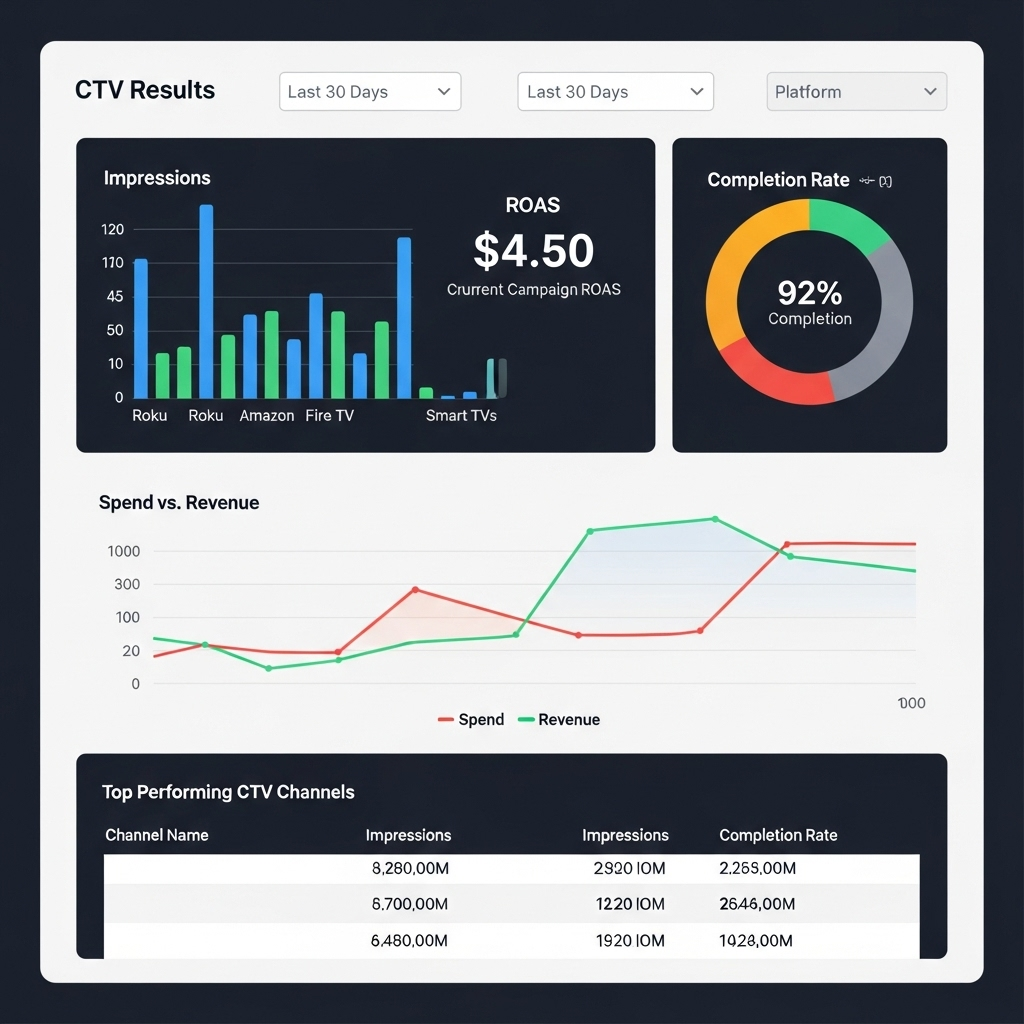CTV Is Here for Marketers — But Is Your Brand Ready to Advertise There?
It’s no longer a question of whether your audience is on Connected TV (CTV) — they are. As of mid-2025, 83% of U.S. households are reachable through a CTV device. Yet many brands still treat this channel as a completely unknown or “maybe someday” tactic.
Here’s the truth: CTV advertising is not niche anymore. It’s mainstream, and many brands are moving beyond relying on linear TV or digital ads alone. CTV is a data-rich channel offering the best of both worlds — premium video storytelling and digital-style targeting.
If you’re not leveraging it, you’re missing out on engaged audiences, measurable results, and a serious edge in your media mix.
So, is your brand ready to advertise on Connected TV? Let’s walk through what you need to know about CTV, and what it takes to get started.
What Is CTV (And How Is It Different from OTT)?
What exactly is CTV? It stands for Connected TV, and understanding the ecosystem is easier than it sounds:
CTV is the device used to consume content, from Smart TVs, Roku, Amazon Fire Stick, gaming consoles, etc.
OTT (Over-the-Top) refers to the method of delivering this content. Think platforms like Netflix, Hulu, YouTube TV, or Disney+.
You may also hear terms like “linear TV” (traditional, scheduled cable programming) or “streaming TV” (a catch-all term that encompasses both OTT and CTV).

The big difference: OTT is the “source,” and CTV is the “medium.” It’s like how Google Analytics distinguishes traffic from “Instagram” (source) and “social” (medium). Think of OTT as the streaming app or platform, and CTV as the screen you watch it on.
For marketers, the key takeaway is this: CTV’s meaning extends far beyond simply watching content. Instead, it’s something you can consider a platform or a channel that provides targeting and measurement capabilities that traditional TV never could.
Why CTV Advertising Matters More Now
The shift in viewer behavior has been rapid and dramatic. Multiple studies show:
- 46% of U.S. internet households are cord-cutters (they’ve canceled cable and rely entirely on streaming).
- 12% are cord-nevers (they’ve never paid for cable).
Together, the majority (58%) of U.S. internet households don’t use cable. That means your media budget should follow them. And unlike digital banners or social video — which compete with distractions on small screens — CTV provides an immersive, co-viewing experience that commands attention.

What Marketers Need to Succeed on CTV
Before you jump into your first campaign, it’s critical to understand what makes CTV advertising effective. Success on this channel isn’t just about showing up; it’s about showing up with a strategy. This includes creative tailored for the medium and a clear understanding of how to reach the right audience without overwhelming them.
Here are a few things you need to make the most out of a ConnectedTV marketing strategy:
1. Strong Creative Built for the Big Screen
This isn’t the place to repurpose your 6-second social clips. Your ad should be:
- High resolution for those large screens
- Visually clean with large, legible text and logos
- Designed for storytelling, not just scrolling
2. A Clear Call-to-Action (CTA)
Whether it’s “Scan the QR code” or “Press OK to Shop,” your audience should know exactly what to do next — without needing to grab their glasses.
3. Smart Frequency Management
Ad fatigue is real. Seeing the same spot three times in one movie isn’t just annoying; it damages brand perception.
- Set aggressive caps (e.g., 2–3 views per user per day)
- Monitor frequency per platform (some are worse offenders than others)
4. Channel-Appropriate Targeting
CTV allows for:
- First-party targeting (upload CRM lists, create lookalikes)
- Third-party audience segments (based on behavior, interests, etc.)
- Contextual targeting (e.g., place your outdoor gear ad during nature shows)
- Device retargeting (serve ads to users who visited your site on mobile or desktop)
When done right, CTV advertising is just as sophisticated as your best-performing digital campaigns, but with the attention and impact of a 50-inch screen.
What’s Holding Most Brands Back from Advertising with CTV?
Despite the momentum, many brands are still sitting on the sidelines when it comes to CTV advertising — and not because they don’t see the potential.
There are a few understandable reasons marketers hesitate. But in 2025 and beyond, these roadblocks are no longer deal-breakers; they’re solvable friction points that shouldn’t stop you from exploring the fastest-growing ad channel on the screen.
Confusion Around CTV vs. OTT
It’s fair: the terminology can be confusing. Even seasoned marketers mix up CTV meaning, how it differs from OTT, and where ads are actually served. It doesn’t help that streaming platforms, hardware devices, and service providers often blur the lines.
But distinctions are getting clearer, and plenty of partners (including agencies like ours) can walk you through the CTV/OTT ecosystem in plain English. Plus, the industry is standardizing language as it matures — so the learning curve is flattening fast.
Assumed High Costs or Complexity
CTV used to feel like something only Fortune 100 brands could afford. And yes, if you’re comparing it to YouTube pre-roll or Meta ads, the cost-per-impression can be higher.
However, platforms like Mountain, The Trade Desk, and Google’s DV360 make it possible to run hyper-targeted, scalable CTV campaigns with modest budgets. Add to that better measurement tools, improved transparency, and performance-focused formats, and CTV is no longer just a branding channel — it’s a conversion opportunity.
Skepticism About Measurement
Speaking of performance… marketers still assume CTV is hard to track; that it only offers top-of-funnel visibility with little ability to prove ROI. Early CTV platforms indeed offered limited metrics. There was a real gap in attribution and performance data.
However, by 2025, measurement had caught up. From QR code scans to conversion lift studies, website traffic uplift, and household-level attribution, brands can now measure CTV performance across the funnel. Better yet, you can connect it to the rest of your media mix to see how it supports other channels.

Lack of Video Assets
Not every brand has a polished video team or an ad-ready reel in their back pocket. That’s especially true for small and mid-sized businesses.
First, not all CTV ads require polished commercial footage. Static overlays, interactive polls, and QR code placements are easy entry points. Second, thanks to AI video tools, low-cost editing platforms (like Canva or Adobe Express), and creative freelancers, building video assets has never been more accessible. And if you do invest in custom video, it can be repurposed across social, landing pages, and more.

It’s Time to Test CTV
CTV belongs in your performance marketing mix. It combines the storytelling power of TV with the precision and accountability of digital — and your audience is already there, watching.
So ask yourself: Why wait? Start with a pilot. Test a shoppable ad. Layer in device retargeting.
Just don’t assume this is a “future” play. Because the future? It’s already on the big screen.
Contact us today to explore strategic direction related to CTV advertising and discover our Paid Media Display Services.





![The Big List of PPC Resources and Articles [Updated for 2025]](https://www.greenlanemarketing.com/wp-content/uploads/2021/08/12-768x401.png)

